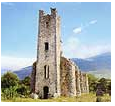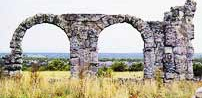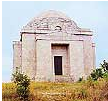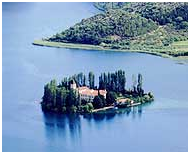Biskupija
It was actually the Bishop of Knin’s estate in the old days and this fact provided its name (eng. “diacese”). It is the most significant early medieval archeological site in Croatia . The remainder of 5 churches (IX-XI ct.) are preserved in Lopuška Glavica, Crkvine and Stupovi. St. Mary’s votive church was built in 1938 (850th anniversary of king Zvonimir’s death) following Ivan Meštrović’s blueprints.
Kapitul

A well known archeological site with remnants of old Croatian churches. The Holy Salvation church is one of the best-preserved early medieval churches in Croatia . A burial ground with more than 800 standing tombstones is located next to the church.
Burnum

A well-known Illyrian camp taken over by the Romans in 33 A.D. In 86 A.D. it became “the city of Roman veterans”. It was destroyed in the Avar-Slavic clashes in 639, but the remainder of the arcades of the headquarters’ building, the pretorium, can still be seen today.
Manastir sv. Arhanđela (Krka)
An orthodox monastery first mentioned in 1402 in connection with the endowment of Jelena, Serbian king Dušan’s sister and Croatian prince Šubić’s widow. Very valuable books and icons are kept in the monastery, as well as important liturgical manuscripts and clothing. A Byzantine style church was built in 1790 with the accompanying Renaissance tower.
Bogočin, Nečven i Trošenj Grad
Ruins of old cities-fortresses, guardians of old Croatian noblemen’s estates. In XII century Bogočin was the centre of one of the twelve Croatian counties and was ruled by the Martinušić and Bogotić families.
Drniš
A city built by the Turks in their conquest of Dalmatia in 1522. Situated in the fertile Petrovom field (once known as the Illyrian field, it got its present name by the last Croatian king Petar Svačić). The Turkish administration period (up to 1684) left many visible marks on the city. Two mosques are preserved as well as the remnants of an old Turkish fortress above the river Čikola canyon. Some of the witnesses of the city’s rich history are the remnants of mosques and minarets, which were dedicated to St Anthony upon Turkish departure. Drniš is today a picturesque town with population of around 4700. Its Regional museum of Drniš district with a permanent exhibition displays a rich cultural and historical heritage ranging from the Neolithic period to the period of Croatian arrival in these areas. It also has a valuable collection of Ivan Meštrović’s work.
Otavice

Birthplace of world-renowned Croatian sculptor, Ivan Meštrović. A mausoleum he built as a tomb for himself and his family is a famous work of art.
Visovac Monastery

An islet in the midst of Visovačko lake, formed by the Krka river, homes a Franciscan monastery, a valuable monument of culture and history. It was first mentioned in 1400 as Lapis Alba (White Rock). It was finished in 1445, the church next to it in 1576. Numerous valuable historical objects, paintings and documents are kept here. Sultan Mehmed’s “ferman” (a special order) to return the monastery to the Franciscans is a most valuable rarity safeguarded there. Some of other valuable items are the cadastral map of Visovac, a collection of Ezop’s fables- an incunabula printed in 1487, as well as the sabre of folk heroVuk Mandušić, killed in the fights against the Turks.
Ključ
Remains of what used to be a fortified town on the river Krka can be seen from the pictoresque Torak spring. It was built in 1330 by the Nelipić aristocratic family, later owned by the Ugrinović family. Tee Turks conqered it in 1522 and left it in 1648.
Skradin
It was an old Illyirian settlement that was to become an important Roman centre called Scardona. The first written mention of the town dates from 339 B.C. The diacese was established in 530. The arrival of Slavs in the VII century saw the destruction of Scardona. The Croats later restored it. Since the X century it has been called by its present name and is referred to in the documents as the Bishop’s seat. It was then under the administrative rule of the Šubić princes from the Bribir region, followed periods of Turkish and Venetian rule. The Nativity of the Virgin (XVIII ct.) church is in the town centre. It is today a beautiful and quiet riverside town with a plethora of historic monuments. In the first week of August it hosts a festival of traditional Dalmatian song (“klape”). The city port is actually one of the entrances to Krka National Park .
Bribirska Glavica – Bribir
One of the richest archeological sites of Illyrian, Roman and Croatian past. In Illyrian and Roman times it was called Berbera. In medieval times it was a fortified town, assuming the role of headquarters for the princes of Šubić family (also known as “Bribirian princes”). At the end of XIII century viceroy Pavao set in motion the building of St. Mary’s church along with a Franciscan monastery. There was a once Neolithic settlement of the so-called “Danilic” culture on a nearby site of Krivača.
Bilice
A village near Prukljansko lake, first mentioned in 1298 upon the formation of the Šibenik diocese. Remnants of old civilisations are visible on several locations. There was even a late Christian basilica there in late Roman period. Valuable archeological findings from the prehistoric era were discovered in St Joseph ‘s channel as well as the ruins of a roman villa rustica at Dedića punta location.
